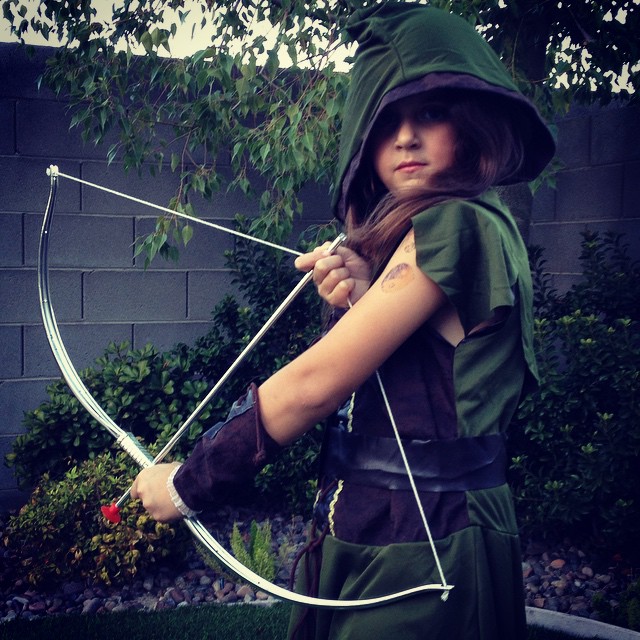Guyside: Girls deserve more than one way to wear a bow.
With the abundance of bow savvy heroines making a mark on the silver screen, it wasn’t any surprise for me to see my daughter don a hood and fill a quiver for Halloween. What was a surprise, however, was how almost every neighbor narrowed their errant guesses to the confines of gender.
“Who are you … Katniss?”
“No.”
“Merida?”
“No.”
“Tauriel from the Hobbit or Susan from the The Chronicles Of Narnia?”
“No and no,” she said. “I’m Robin Hood.”
She said it with enough conviction to corral the conversation. She was Robin Hood and the only person who questioned her about being a girl was a 5-year-old boy. Once she reassured him that a girl could be Robin Hood, he turned his attention to her bow and arrows. Next year, he said in wide-eyed wonder, he would be Robin Hood.
Next year, she said, she would like to be a princess like she was two years ago too. The only bow she sported back then was a yellow one to tie her hair back. But the year before that she was a pirate. And the year before that, she was a wood fairy in the vein of Tinkerbell. There are no limits to her imagination, especially those related to gender.
It’s part of a trait I hope she retains all her adult life too — the art of being gender ambidextrous, whereby every decision she makes is made based on passion and aptitude over the societal shakedowns over being feminine and a feminist. Life is complicated enough without trying to conform to a stereotype or work even harder to avoid one.
It seems to me that there is something inherently wrong when our daughters think that they have to ask permission whether or not they can dress up like Han Solo for Halloween. And while the girl who asked was very fortunate to have Tom Burns (who dressed up as Princess Leia) as a dad, it still haunts me that any 7-year-old girl would be so cognizant of gender-flipping costumes.
It’s almost worrisome as the growing number of parents who think the princess syndrome needs to be cured in seconds. It doesn’t.
Kids aren’t really part of the good role model/bad role model debate unless they are indoctrinated by the people who invented it. Sure, some stories might carry moral messages but none of the princesses really auditioned for the role model moniker (and neither did their princely counterparts, who suffer all sorts of severe character flaws).
The far greater danger is to perpetuate the myth that feminine and feminism have to somehow exist as polar opposites. They don’t. If the operative word is choice, then let girls make their own.
My daughter feels equally comfortable in a sundress or her fast-pitch softball uniform, which is usually covered in dirt five minutes before the warmups are over. She has an appreciation for art and music as much as for engineering and science. She is just as likely to play with Hot Wheels as Barbies, but is no more inclined to wish for wheels instead of feet than she is for that impossible waistline. She enjoys dodgeball as much as Girl Scouts and, on any given day, can show off a pirouette or hold a plank position.
It’s a freedom that I hope she preserves all her life, not as someone who is gender ambiguous but rather gender ambidextrous. Women should never feel forced to give up a stitch of gender identity to achieve equality. On the contrary, it will be my daughter’s ability to embrace her gender without being made a slave to it that will eventually empower her generation to move beyond the idiocy exhibited at companies like Zillow or Uber.
Robin Hood, after all, didn’t ask the poor to fix the inequality of his era. He wanted the rich to change their behavior.
Read MoreGuyside: How to diet and exercise like your life depends on it.
 You would think that surviving cancer would be enough, but it’s not. Completing cancer treatments or undergoing surgery is only the beginning. Most cancer survivors are eager to return to good health, but aren’t always ready to think beyond recovery.
You would think that surviving cancer would be enough, but it’s not. Completing cancer treatments or undergoing surgery is only the beginning. Most cancer survivors are eager to return to good health, but aren’t always ready to think beyond recovery.
It’s even more challenging for anyone who discovers they have additional health complications prior to being diagnosed or as a by-product of recovery. The last thing you want to hear as a cancer survivor is that you’re also a high risk for heart disease.
That was me. Despite resuming my regular exercise schedule six weeks after surgery, I was disappointed to discover both — the high cholesterol prior to being diagnosed with kidney cancer was higher and my borderline high blood pressure had become high, a common by-product after a radical nephrectomy.
My previous doctor was already convinced that diet and more exercise wouldn’t help. He said my cholesterol, particularly my LDL (the so called “bad cholesterol”) was too high to bring down. In fact, had I not been diagnosed with kidney cancer, he would have prescribed a regimen of medication, statins or likely some alternative.
“As high as your cholesterol is? You’ll never do it,” he said. “Don’t worry about it. You‘ll be able to eat what you want and these little pills will take care of it.”
When my new doctor noted the same findings, he almost reached the same conclusion. The only reason he didn’t? I had six months to prepare a counter offer, promising to increase my cardio and incorporate any diet pointers that he was willing to offer up.
“All right,” he said, printing off an article on a high fiber diet. “I think your previous doctor was probably right, but read this, do what it says, and I’ll see you in three months.”
Developing a diet and exercise program like your life depends on it.
Three months didn’t seem like a very long time to me. I even asked for him six months, but he wasn’t interested in negotiating. So I left with his three-page diet article and researched some cardio exercise options. That was the plan. Diet and exercise.
Exercise. Not everything is easy for me. In junior high school and the first year of high school, I learned the hard way that I am prone to shin splints. It is the result of being born with congenital talipes equinovarus (club feet). While my feet were corrected, running long distances places additional stress on abnormally short tendons.
As an alternative, I adapted a two-minute workout that required less running while delivering more intensity. The fast-paced routine suggested 20 seconds of six different exercises: high knees, jumps, mountain climbers, single leg hops, squats, and jumping jacks. Once it felt easy, I adapted it to forego the 20-second timer.
By changing the time system to a count system, I no longer had to rely on a timer or glance at a clock. The adapted routine simply includes 100 high knees, 12 jumps, 24 mountain climbers, 20 side-to-side single leg hops, 12 squats, and 20 jumping jacks. I used to do it a few times every day until I started to repeat the cycle (after one cycle felt too easy).
This cardio exercise now augments my regular weight-lifting schedule. I usually perform my cardio in the morning and weight training in the afternoon. Everyone has preferences.
Diet. While my doctor suggested becoming a vegetarian over the long term, I focused instead on what felt realistic and attainable. For me, someone who was raised on a meat-and-potatoes Midwest diet, this simply meant making lateral changes that increased fiber while decreasing saturated fats and proteins that are high in fat or cholesterol.
By lateral changes, I mean that I changed out cereal with milk or eggs for oatmeal and a protein bar. I changed out deli sandwiches on wheat for peanut butter and jelly on whole wheat or shredded turkey on salad and then added an apple or a pear. I changed my family’s weekly dinner entrees from one or two beef, one or two pork, and the balance chicken or seafood to mostly chicken, one or two seafood and fish, one turkey, one pork (or less), and beef every other week. Since I cook the majority of our dinners, it was easy to swap olive oil in recipes calling for butter and other oils. I reduced my dairy intake.
There are dozens of smaller changes that worked out well too. For instance, since I have always enjoyed potato chips, I added a handful of natural sea salt kettle chips at lunch and sunflower seeds at any other time. Rather than having ice cream or some other sweet at night, I might have an apple or a pear. Nuts can help reduce cholesterol too.
It seems to me that the real key was finding an appropriate substitute to satisfy any craving. When that wasn’t possible, I chose moderation over scarcity and sacrifice. If I ate an apple and still craved ice cream, one spoonful would do it. Other times I had a restaurant dessert, lunch-pack bag of chips, or whatever I else wanted. It’s no big deal.
“Keep doing what you are doing,” said my doctor after three months. “Stay on the path, Obi Wan.”
Succeeding with a new exercise routine or changing your diet isn’t won with fads or sacrifice because it’s not a race. It’s a marathon, which makes process goals more important than performance goals. Focus on doing and not what you want done.
Yes, this can be frustrating at times. I had no idea whether my exercise and diet shift was working or not. Only blood pressure checks and a blood test would eventually prove it.
After three months, my blood pressure normalized despite having one kidney and a reasonably stressful job. My cholesterol (including LDL) dropped within two points of normal, enough to prompt my doctor to talk more about studies that are starting to question the logic of treating borderline high cholesterol than those recommending statin alternatives. I also lost ten pounds without giving up any muscle gain as a bonus and have currently adjusted my fitness program to include more core exercises to trim up my waistline because my goals have changed. I’ve lost two inches in four weeks.
Sure, what I did over the course of three months won’t necessarily work for everyone. But if you are like me and would prefer to remain med free, always remember that you don’t really know what exercise and diet can do until you try it. Your body might even surprise you. Mine continues to surprise me. I’m studying to become a personal trainer.
Read More






